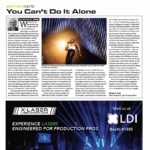We all have our specialties when it comes to the business. In the attempt to make a name for ourselves, each of us has carved a specific niche. But sometimes our path to success does not go the way we originally planned, or even imagined. I am a prime example. I knew early on that lighting design was where I wanted to go. But if you were to go back in a time machine and ask my former self if I thought I might be destined to become a writer and an editor of a magazine, I would have laughed hysterically. (I still do that sometimes; I guess that is my jolly nature.)
Plan B…or Maybe C
I still am doing what I love, which is entertainment lighting design, though in a vastly different role than what I originally imagined. My original goal was theatrical design. Yes, I had that dream of going to Broadway and making it big. Then reality stepped in, and I found different opportunities within the industry to prosper and grow.
Did you notice how I said “entertainment lighting design” and not something specific like, say, “concert lighting” or “corporate events?” That’s because I love doing them all — that is, when I am not on deadline for the magazine. Theatrical, corporate events, concerts — they all allow for some freedom of design and imagination.
An Unforgiving Lens
One area of lighting design that still has me striving to do better is TV and I-Mag. It’s not that lighting for the camera is much more difficult than for the live audience; it just takes a different approach. When lighting for the camera, you have an “eye” that is less forgiving, as far as over- or under-exposure, than the naked human eye.
Take, for instance a rock concert. Sitting front of house, you’ll see an ocean of camera phones and point-and-clicks trying to capture the talent on stage. If you surf Instagram for photos like that, the stage seems washed out and over-exposed. Typically, the fans won’t notice the problem until they get home and realize that all their photos look like crap. Quite naturally, they don’t understand — the stage looked amazing when they were there in person.
Despite today’s advanced camera technology and the amazing ability to capture low light level interiors without the use of flash, the mechanical iris can’t auto-correct the way the human eye can. Even something as simple as a panel discussion on a stage, which might not need much more than a basic stage wash for the human audience, might require more strategic lighting for I-Mag, DVD recording or broadcast so that the stage, which might look fine to the audience, doesn’t appear blown out on the screens.
Our eyes have the ability to correct for these changes in lighting through the dilation of our pupils. It’s the beauty of our autonomic system that makes this happen. We don’t have to think about it — it’s just like the beating of our hearts. Our nervous system kicks in and adjusts our pupils so we can either see a high light level or the dimmest of scenes.
Strategically lighting for the camera increases the odds for success. And, as it turns out, lighting for the camera uses many of the same principles that all forms of lighting design follow. The difference is in the levels, and the end results on screen.
Not Autonomic
Lighting for the camera is a challenge, but one that can be overcome. It just takes diligence, research, time and, most important, trial and error. I have had my fair share of missteps along the way and remember them each time they begin to crop up in the current project.
Just remember that the camera is our friend, and the guy behind the camera is our best friend. Your lighting can make their jobs easier, but even when stages are lit for a live audience only, expert photographers can capture the moment and make it look as good as it did to the human eye.
Want proof? Just look at the quality of some of the images appearing in the pages that follow. Instagram proves that it’s not easy to point, shoot and score. But with the right gear, preparation and experience, it can be done.


